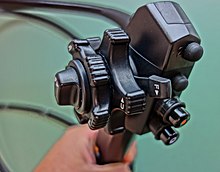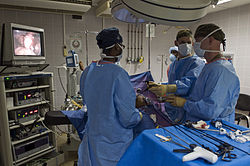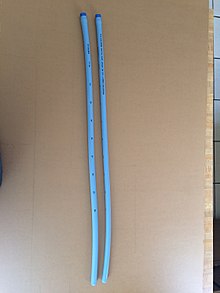Endoscopy
This articleneeds additional citations forverification.(January 2016) |
| Endoscopy | |
|---|---|
 An example of an endoscopic procedure | |
| MeSH | D004724 |
| OPS-301 code | 1-40...1-49,1-61...1-69 |
| MedlinePlus | 003338 |
Anendoscopyis a procedure used inmedicineto look inside the body.[1]The endoscopy procedure uses anendoscopeto examine the interior of a hollow organ or cavity of the body. Unlike many othermedical imagingtechniques, endoscopes are inserted directly into the organ.
There are many types of endoscopies. Depending on the site in the body and type of procedure, an endoscopy may be performed by either a doctor or asurgeon.A patient may be fully conscious oranaesthetisedduring the procedure. Most often, the termendoscopyis used to refer to an examination of the upper part of thegastrointestinal tract,known as anesophagogastroduodenoscopy.[2]
For nonmedical use, similar instruments are calledborescopes.
History
[edit]Adolf Kussmaulwas fascinated bysword swallowerswho would insert a sword down their throat without gagging. This drew inspiration to insert a hollow tube for observation; the next problem to solve was how to shine light through the tube, as they were still relying on candles and oil lamps as light sources.[3]
The termendoscopewas first used on February 7, 1855, by engineer-optician Charles Chevalier, in reference to theuréthroscopeofDésormeaux,who himself began using the former term a month later.[4]The self-illuminated endoscope was developed atGlasgow Royal InfirmaryinScotland(one of the first hospitals to have mains electricity) in 1894/5 byJohn Macintyreas part of his specialization in the investigation of the larynx.[5][failed verification]
Medical uses
[edit]

Endoscopy may be used to investigate symptoms in thedigestive systemincludingnausea,vomiting,abdominal pain,difficulty swallowing,andgastrointestinal bleeding.[6]It is also used in diagnosis, most commonly by performing a biopsy to check for conditions such asanemia,bleeding,inflammation,andcancers of the digestive system.[6]The procedure may also be used for treatment such ascauterizationof a bleeding vessel, widening a narrow esophagus, clipping off a polyp or removing a foreign object.[6]
Specialtyprofessional organizationsthat specialize in digestive problems advise that many patients withBarrett's esophagusreceive endoscopies too frequently.[7]Such societies recommend that patients with Barrett's esophagus and no cancer symptoms after two biopsies receive biopsies as indicated and no more often than the recommended rate.[8][9]
Applications
[edit]


Health care providers can use endoscopy to review any of the following body parts:
- Thegastrointestinal tract(GI tract):
- oesophagus,stomachandduodenum(esophagogastroduodenoscopy)
- small intestine(enteroscopy)
- large intestine/colon(colonoscopy,sigmoidoscopy)
- Magnification endoscopy
- bile duct
- endoscopic retrograde cholangiopancreatography(ERCP), duodenoscope-assisted cholangiopancreatoscopy, intraoperative cholangioscopy
- rectum(rectoscopy) andanus(anoscopy), both also referred to as (proctoscopy)
- Therespiratory tract
- Thenose(rhinoscopy)
- The upperrespiratory tract(laryngoscopy)
- The lowerrespiratory tract(bronchoscopy)
- Theear(otoscope)
- Theurinary tract(cystoscopy)
- Thefemale reproductive system(gynoscopy)
- Thecervix(colposcopy)
- Theuterus(hysteroscopy)
- Thefallopian tubes(falloposcopy)
- Normally closed body cavities (through a small incision):
- The abdominal or pelvic cavity (laparoscopy)
- The interior of a joint (arthroscopy)
- Organs of the chest (thoracoscopyandmediastinoscopy)
Endoscopy is used for many procedures:
- Duringpregnancy
- Plastic surgery
- Panendoscopy (or triple endoscopy)
- Combineslaryngoscopy,esophagoscopy,andbronchoscopy
- Orthopedic surgery
- Hand surgery,such asendoscopic carpal tunnel release
- Knee surgery,such asanterior cruciate ligament reconstruction
- Epidural space(epiduroscopy)
- Bursae(bursectomy)
- Endodonticsurgery
- Maxillary sinussurgery
- Apicoectomy
- Endoscopic endonasal surgery
- Endoscopic spinal surgery
- Endoscopicnerve decompressionforperipheral nerves
An endoscopy is a simple procedure that allows a doctor to look inside human bodies using an instrument called an endoscope. A cutting tool can be attached to the end of the endoscope, and the apparatus can then be used to perform minor procedures such as tissue biopsies, banding of oesophageal varices or removal of polyps.
Application in other fields
[edit]- For non-medical use, such as internal inspection of complex technical systems,borescopesare used. These are similar to endoscopes.
- The planning and architectural community usearchitectural endoscopyfor pre-visualization of scale models of proposed buildings and cities
- Endoscopes are also a tool helpful in the examination ofimprovised explosive devicesbybomb disposalpersonnel.
- Law enforcement uses endoscopes for conducting surveillance via tight spaces.
Risks
[edit]The main risks are infection, over-sedation, perforation, or a tear of the stomach or esophagus lining and bleeding.[10]Although perforation generally requires surgery, certain cases may be treated with antibiotics and intravenous fluids. Bleeding may occur at the site of a biopsy or polyp removal. Such typically minor bleeding may simply stop on its own or be controlled by cauterisation. Seldom does surgery become necessary. Perforation and bleeding are rare during gastroscopy. Other minor risks include drug reactions and complications related to other diseases the patient may have. Consequently, patients should inform their doctor of all allergic tendencies and medical problems. Occasionally, the site of thesedativeinjection may become inflamed and tender for a short time. This is usually not serious and warm compresses for a few days are usually helpful. While any of these complications may possibly occur, each of them occurs quite infrequently. A doctor can further discuss risks with the patient with regard to the particular need for gastroscopy.
After the endoscopy
[edit]After the procedure, the patient will be observed and monitored by a qualified individual in the endoscopy room, or a recovery area, until a significant portion of the medication has worn off. Occasionally the patient is left with a mild sore throat, which may respond to saline gargles, or chamomile tea. It may last for weeks or not happen at all. The patient may have a feeling of distention from the insufflated air that was used during the procedure. Both problems are mild and fleeting. When fully recovered, the patient will be instructed when to resume their usual diet (probably within a few hours) and will be allowed to be taken home. Where sedation has been used, most facilities mandate that the patient be taken home by another person and that they not drive or handle machinery for the remainder of the day. Patients who have had an endoscopy without sedation are able to leave unassisted.
References
[edit]- ^"Endoscopy".British Medical Association Complete Family Health Encyclopedia.Dorling Kindersley Limited. 1990.ISBN978-0-751-30161-8.
- ^"Endoscopy".Cancer Research UK. Archived fromthe originalon 1 February 2017.Retrieved5 November2015.
- ^"The pioneers of endoscopy and the sword swallowers".Archivedfrom the original on 2022-01-27.Retrieved2022-01-26.
- ^Janssen, Diederik F (2021-05-17)."Who named and built the Désormeaux endoscope? The case of unacknowledged opticians Charles and Arthur Chevalier".Journal of Medical Biography.29(3): 176–179.doi:10.1177/09677720211018975.ISSN0967-7720.PMID33998906.S2CID234747817.Archivedfrom the original on 2023-02-04.Retrieved2021-05-17.
- ^"The Scottish Society of the History of Medicine"(PDF).Archived(PDF)from the original on 2016-12-20.Retrieved2017-07-11.
- ^abcStaff (2012)."Upper endoscopy".Mayo Clinic.Archivedfrom the original on 25 May 2013.Retrieved24 September2012.
- ^American Gastroenterological Association,"Five Things Physicians and Patients Should Question"(PDF),Choosing Wisely: an initiative of theABIM Foundation,American Gastroenterological Association,archived fromthe original(PDF)on August 9, 2012,retrievedAugust 17,2012
- ^Spechler SJ, Sharma P, Souza RF, Inadomi JM, Shaheen NJ (March 2011)."American Gastroenterological Association medical position statement on the management of Barrett's esophagus".Gastroenterology.140(3): 1084–91.doi:10.1053/j.gastro.2011.01.030.PMID21376940.
- ^Wang KK, Sampliner RE (March 2008)."Updated guidelines 2008 for the diagnosis, surveillance and therapy of Barrett's esophagus".The American Journal of Gastroenterology.103(3): 788–97.doi:10.1111/j.1572-0241.2008.01835.x.PMID18341497.S2CID8443847.
- ^"Endoscopy".NHS Choices.NHS Gov.UK.Archivedfrom the original on May 2, 2017.RetrievedApril 20,2017.
External links
[edit]- The Atlas of Gastrointestinal Endoscopyendoatlas.com
- El Salvador Atlas of Gastrointestinal Endoscopy
- Gastrolab: Site in English, Swedish and Finnish with gastrointestinal endoscopy photolibraryArchived2020-07-10 at theWayback Machine
- Preventing cross-contamination from flexible endoscopesmassdevice.com
- Advances in EndoscopyArchived2018-05-13 at theWayback Machineadvancedimagingpro.com
